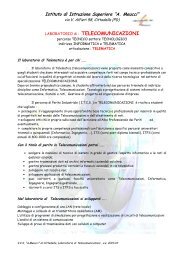Agar gel immunodiffusione (AGID) per la ricerca di anticorpi verso ...
Agar gel immunodiffusione (AGID) per la ricerca di anticorpi verso ...
Agar gel immunodiffusione (AGID) per la ricerca di anticorpi verso ...
You also want an ePaper? Increase the reach of your titles
YUMPU automatically turns print PDFs into web optimized ePapers that Google loves.
DeSCRIZIONe<br />
VIROLOGIA - LABORATORIO VIR - sezione <strong>AGID</strong><br />
Protocollo<br />
<strong>Agar</strong> <strong>gel</strong> <strong>immuno<strong>di</strong>ffusione</strong> (<strong>AGID</strong>) <strong>per</strong> <strong>la</strong> <strong>ricerca</strong> <strong>di</strong> <strong>anticorpi</strong> <strong>verso</strong> virus influenzali <strong>di</strong> tipo A<br />
I virus influenzali si <strong>di</strong>vidono in tre tipi: A, B<br />
e C. I virus che causano l’influenza aviaria<br />
appartengono al tipo A.<br />
La presente procedura ha lo scopo <strong>di</strong> descrivere<br />
le modalità o<strong>per</strong>ative connesse al<strong>la</strong> <strong>ricerca</strong> degli<br />
<strong>anticorpi</strong> nei confronti dei virus influenzali aviari<br />
<strong>di</strong> tipo A nei vo<strong>la</strong>tili non-acquatici me<strong>di</strong>ante prova<br />
<strong>di</strong> <strong>Agar</strong> Gel Immuno Diffusione (<strong>AGID</strong>). L’<strong>AGID</strong>, <strong>per</strong><br />
le specie pollo e tacchino, è considerata meto<strong>di</strong>ca<br />
<strong>di</strong> riferimento o gold standard.<br />
Il test è in grado <strong>di</strong> evidenziare <strong>la</strong> reazione<br />
antigene-anticorpo attra<strong>verso</strong> <strong>la</strong> formazione <strong>di</strong><br />
un complesso insolubile, visibile sotto forma <strong>di</strong><br />
bande <strong>di</strong> precipitazione, a partire da reagenti<br />
(antigene e anticorpo) solubili.<br />
Essendo l’antigene <strong>di</strong> gruppo comune a tutti<br />
i virus influenzali aviari <strong>di</strong> tipo “A”, questa<br />
prova <strong>per</strong>mette <strong>di</strong> sve<strong>la</strong>re gli <strong>anticorpi</strong> indotti<br />
da qualunque sottotipo <strong>di</strong> virus influenzale.<br />
Non si applica ai sieri dei vo<strong>la</strong>tili acquatici, in<br />
quanto questi vo<strong>la</strong>tili hanno una scarsa o nul<strong>la</strong><br />
produzione <strong>di</strong> <strong>anticorpi</strong> precipitanti.<br />
MATeRIALI<br />
Reagenti<br />
•<br />
•<br />
•<br />
•<br />
•<br />
•<br />
Antigene virale inattivato (specifico <strong>per</strong> agar <strong>gel</strong><strong>di</strong>ffusione)<br />
Siero i<strong>per</strong>immune specifico <strong>per</strong> l’antigene in esame<br />
(siero positivo <strong>di</strong> riferimento)<br />
Acqua <strong>di</strong>stil<strong>la</strong>ta<br />
Cloruro <strong>di</strong> so<strong>di</strong>o (NaCl)<br />
<strong>Agar</strong> Noble<br />
Sieri in esame<br />
OBIeTTIVO<br />
In<strong>di</strong>viduare gli <strong>anticorpi</strong> indotti dai virus influenzali aviari<br />
DURATA<br />
1h 30”<br />
StRumenti<br />
•<br />
•<br />
•<br />
•<br />
•<br />
•<br />
•<br />
•<br />
Piastre Petri da 90 mm <strong>di</strong> <strong>di</strong>ametro<br />
Vetreria sterile (cilindri graduati e becher)<br />
Forno a microonde<br />
Bi<strong>la</strong>ncia tecnica<br />
Micropipette a volume variabile 5-50 µl<br />
Stampo in acciaio<br />
Illuminatore a luce <strong>di</strong>ffusa (o <strong>la</strong>mpada da tavolo)<br />
Camera umida
pROCeDIMeNTO<br />
1. Preparazione delle piastre <strong>di</strong> agar<br />
•<br />
•<br />
•<br />
•<br />
•<br />
Sciogliere in un becher contenente 100 ml <strong>di</strong> acqua<br />
<strong>di</strong>stil<strong>la</strong>ta 8 g <strong>di</strong> NaCl<br />
Aggiungere 1,25 g <strong>di</strong> <strong>Agar</strong> Noble e agitare<br />
delicatamente<br />
Immergere in un bagnomaria in ebollizione oppure<br />
immetterlo nel forno a microonde<br />
Verificare in controluce che l’agar si sia sciolto<br />
completamente, altrimenti ripetere il punto<br />
precedente<br />
Distribuire, su <strong>di</strong> una su<strong>per</strong>ficie <strong>per</strong>fettamente<br />
orizzontale, 15 ml del<strong>la</strong> soluzione <strong>di</strong> agar nelle<br />
2. esecuzione dell’analisi<br />
•<br />
•<br />
•<br />
•<br />
Portare a tem<strong>per</strong>atura ambiente un numero<br />
sufficiente <strong>di</strong> piastre <strong>per</strong> i campioni in esame e<br />
contrassegnare le piastre sul<strong>la</strong> parte <strong>la</strong>terale con il<br />
numero identificativo dei campioni<br />
Praticare sullo strato <strong>di</strong> agar fori come in<strong>di</strong>cato nello<br />
schema, aspirando/rimuovendo l’agar dai pozzetti<br />
Distribuire 25 µl <strong>di</strong> antigene (Ag) nel pozzetto<br />
centrale e 25 µl <strong>di</strong> antisiero positivo (S+) in due<br />
pozzetti <strong>per</strong>iferici <strong>di</strong>ametralmente opposti, e i sieri in<br />
esame (SE) nei rimanenti pozzetti, in senso orario<br />
Incubare le piastre in camera umida a<br />
tem<strong>per</strong>atura ambiente <strong>per</strong> 48 ore<br />
3. Lettura e interpretazione dei risultati<br />
•<br />
•<br />
Dopo 48 ore osservare le piastre con una<br />
fonte <strong>di</strong> luce <strong>di</strong>ffusa <strong>per</strong> apprezzare le bande<br />
<strong>di</strong> precipitazione. La prova si considera valida<br />
se si osserva <strong>la</strong> banda <strong>di</strong> precipitazione<br />
dell’immunocomplesso (antigene-anticorpo) fra<br />
i pozzetti contenenti l’antisiero positivo e quello<br />
centrale contenente l’antigene.<br />
In caso <strong>di</strong> negatività del campione, non si osserverà<br />
<strong>la</strong> banda <strong>di</strong> precipitazione e il campione viene<br />
definito “negativo”.<br />
•<br />
•<br />
•<br />
•<br />
•<br />
piastre Petri<br />
Lasciare raffreddare e soli<strong>di</strong>ficare l’agar nelle<br />
piastre a tem<strong>per</strong>atura ambiente senza co<strong>per</strong>chio<br />
Chiudere le piastre, scrivere <strong>la</strong> data <strong>di</strong> produzione,<br />
porre le piastre in un sacco <strong>di</strong> p<strong>la</strong>stica e sigil<strong>la</strong>rlo<br />
Porle così sigil<strong>la</strong>te in frigorifero capovolte (<strong>per</strong><br />
evitare che <strong>la</strong> condensa si accumuli) e utilizzare<br />
entro 15 giorni<br />
In caso <strong>di</strong> positività del campione, si osserverà una<br />
banda <strong>di</strong> precipitazione in continuità con <strong>la</strong> banda<br />
ottenuta tra l’antigene e l’antisiero positivo, e il<br />
campione viene definito “positivo”.<br />
Il campione che fornisce risultati <strong>di</strong>versi da quelli<br />
descritti <strong>per</strong> il campione positivo viene definito<br />
“negativo”.<br />
Protocollo






